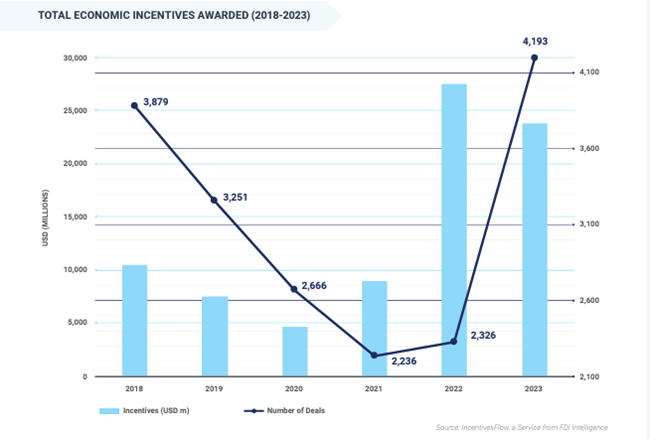In 2023, state and local governments provided $23.7 billion in economic incentives to businesses nationwide.
To put that in perspective, it’s more than the gross domestic product of countries like Albania, Malta, Jamaica or Nicaragua.
While that is slightly less than the amount of incentives paid out in 2022, it’s still more than all incentives offered from 2018 to 2021… combined.
Governments use these incentives to sweeten the deal and bring new businesses to their area.
And the most common tactic is to offer tax breaks on goods and properties.
Suppose you run a company and you want to expand. In that case, governments will waive taxes on equipment you buy and property you use as long as you invest a certain amount in the expansion, employ a certain number of people and pay above a certain wage.
It’s a sweet deal if you can get it.
In 2023, the biggest sector beneficiaries were tied to semiconductor manufacturing, electric vehicles and EV battery manufacturing.
I want to focus on a segment that flew under the radar a bit. Nearly $2 billion in economic incentives were tied to data center projects.
However, some lawmakers are questioning data center incentives … and even pulling some off the table.
Today, I’ll show you why the solution will please both governments and Big Tech simultaneously.
The Data Center Boom
Big Tech companies like Apple, Google, Amazon and Meta need data centers.
Every time you post a picture on Instagram, buy something online from Amazon or stream a movie on AppleTV, data from those activities are stored in data centers.
As of March 2024, the U.S. had 5,381 data centers — more than Germany, the United Kingdom, China, Canada, France and Australia … combined.
With the rise of artificial intelligence, Big Tech will have to build out data centers on a massive scale.
The founder and CEO of Dell Technologies, Michael Dell, said data center capacity will have to increase by 100x over the next decade.
State and local governments are taking advantage of this by offering Big Tech companies massive incentive packages to build new facilities in their backyards.
In addition to tax breaks on equipment and property, governments are even offering breaks on electricity usage. So while you and I pay normal electricity rates, these tech companies with power consumption needs often pay a reduced rate in states like North Carolina, South Carolina, Tennessee and Texas.
Data centers already used massive amounts of power before the onset of the AI mega trend, and now that usage is only getting larger as companies implement power-hungry AI chips into their data center infrastructure:
Consulting firm McKinsey & Co. projects data center power usage will grow from 17 gigawatts in 2022 to 35 gigawatts by 2030.
That’s enough to power more than 26 million homes in the U.S.
Some governments are reconsidering offering tax incentives for data centers because it strains the reliability and affordability of local electric grids.
In Georgia — home to more than 50 data centers — lawmakers are working on legislation to pause economic incentives to data centers, while in South Carolina, the House passed a measure to prevent data centers from receiving discounted power rates. The Senate removed that measure.
All of this puts the AI mega trend at a crossroads.
Data centers need power to operate, but governments are becoming leery of giving rate breaks to these power-hungry centers for fear of passing those costs on to taxpayers.
But there is a solution…
We Don’t Need Data Center Tax Breaks
The challenge is simple: How can we keep building data centers to support AI expansion without blowing up existing power grids or causing a massive burden to taxpayers?
The solution isn’t in new policy but in new technology.
Our chief investment strategist, Adam O’Dell, has uncovered the one company with the power (pun intended) to solve this critical issue.
It’s already well ahead of its competition after spending billions on research and development and cutting through regulatory red tape.
Big Tech firms like Apple, Google, Amazon and Meta are going to look to this one small company to solve this crossroads crisis.
Adam just released a special presentation on this critical piece of technology the AI mega trend needs, not just to sustain … but to thrive.
You don’t want to miss out on this massive opportunity, so be sure to click here and learn more about this next innovation in the AI revolution.
You and your portfolio will be happy you did.
Until next time…
Safe trading,

Matt Clark, CMSA®
Chief Research Analyst, Money & Markets






